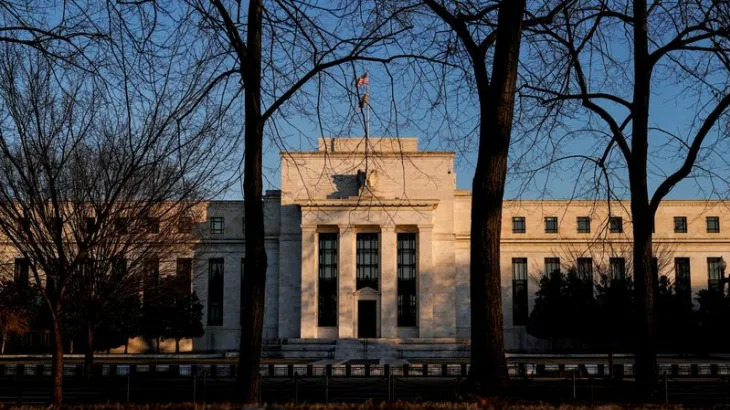

Higher rates have been playing out on stocks, cryptocurrency and commodities such as oil over the past few years. But what can investors expect from here and how long will the rate environment impact markets?
For more than two years the prospect of higher interest rates has been affecting markets, but the direction of rates hit a turning point in mid-2023. In nine of its last 10 meetings, including the one ending July 31 , the Federal Reserve has opted to hold rates steady, after raising rates 11 times in this economic cycle. Now, few analysts doubt that rates are poised to move lower soon, as inflation – which hit 3 percent in June – comes increasingly under control.
Higher rates and recession fears losing effect on the market
While the Fed has raised rates 11 times during this tightening cycle, it’s easy to spot when markets really sat up and took notice that the central bank wasn’t kidding that it was about to recalibrate monetary policy. It was November 2021 when cryptocurrency and many of the riskiest stocks peaked.
“When the Fed introduced restrictive monetary policies by increasing rates in 2022, this caused equity markets and cryptocurrencies to appropriately decline in valuation,” says Octavio Sandoval, director of investments at Illumen Capital.
“The stock market will never not worry about future interest rates,” says Steve Azoury, head of Azoury Financial in Troy, Michigan. “The cost of borrowing impacts all areas of investing, purchasing and savings. Just the anticipation of what may happen is enough to cause a stock market reaction.”
And the direction of rates seems to be frightening investors less these days, as they see the future path of interest rates likely heading lower.
While major stock indexes such as the Standard & Poor’s 500 spent most of 2022 in a funk due to rising rates, they fared well in 2023. The S&P 500 rose about 24 percent last year, while the Nasdaq Composite climbed around 43 percent. They followed that up with a strong first half this year, though they’ve retreated a bit from their recent all-time highs.
But what about the highly expected recession? The market’s recent relative strength suggests that investors may be more optimistic – or at least, less pessimistic – than they were before. Many analysts forecast a so-called “soft landing” for the economy, a scenario where inflation declines and unemployment rises some but the economy does not go into a full recession.
But after a strong run-up in 2023 and 2024, there may yet be plenty of room for markets to fall further if the economy worsens significantly .
Many unprofitable high-growth stocks had a rough 2022, and while prices firmed up in 2023, that doesn’t mean these stocks are still anywhere close to their prior highs. For example, software stocks such as Cloudflare, Zoom Video Communications and Confluent are worth less than half their all-time highs. Nonetheless, profitable big-name stocks such as Microsoft, Apple and others in the Magnificent 7 fared well despite the moves in rates.
Cryptocurrency prices struggled as interest rates looked to move higher, but now that rates look poised for a fall in the near term, crypto prices have risen substantially. And the introduction of Bitcoin ETFs has helped boost the price of Bitcoin, which hit an all-time high in March. The prospect of lower rates and inflows to ETFs have pushed Ethereum higher, too.
Will lower interest rates derail stocks?
Stocks and cryptocurrency endured notable volatility as investors factored in rising rates. But what’s in store for the next six months, with the Fed expected to lower rates as soon as September?
The expectation of lower interest rates has helped buoy rate-sensitive sectors such as banks and real estate investment trusts (REITs) . Small-cap indexes such as the Russell 2000 have also fared well in recent weeks, as the market began to price in the possibility of rate cuts happening soon. At the same time, the imminent arrival of lower rates hasn’t seemed to boost big tech names such as Apple, Microsoft and Amazon, which fell well off their 52-week highs.
Market watchers are still divided as to whether the Fed will keep rates too high for too long and whether that’s already reflected in current stock prices. This uncertainty itself drives volatility in the markets.
“I fear that this approach of not cutting rates, or fear of cutting interest rates too early, may push the economy into a short-term recession,” says Dan Raju, CEO of Tradier, a brokerage platform.
“The soft landing narrative seems to have taken hold, but there continues to be plenty of market participants skeptical that this is actually going to happen,” says Brian Spinelli, co-chief investment officer at wealth advisor Halbert Hargrove in Long Beach, California.
In the meantime, markets continue to re-adjust to the economic environment with the expectation that rates are poised to move lower.
The bellwether 10-year Treasury, now offering a 4.12 percent yield, is well below its 52-week high of 4.99 percent set in October, after a surge to start the year, and it’s been falling in recent weeks.
Now, with short-term rates well above longer-term rates – a so-called yield-curve inversion – many market watchers are still expecting a recession to occur in 2024. A recession would likely push the stock market even lower until investors can begin to gauge the length and depth of any upcoming downturn. But that may not stop stocks from rallying intermittently.
How interest rates have affected crypto and commodities markets
Two other major asset classes have had varied responses in the face of higher rates. While cryptocurrency prices plummeted along with other risky assets, many commodities spiked higher in early 2022, including oil, but many of those moves proved short-lived. With the rising Fed funds rate slowing and then pausing in 2023, both oil and crypto seem to have found some support. And now with lower rates in the offing, both have found an extra tailwind.
Cryptocurrency has often been touted as a cure-all for what ails you , whether that’s inflation, low interest rates, lack of purchasing power, devaluation of the dollar and so on. Those positives were easy to believe in as long as crypto was rising, seemingly regardless of other assets.
“The truth is that crypto prices have proven to be impacted by the same directional sentiment that impacts retail stock investors,” says Raju. “In general, high interest rates scare investors away from riskier investments like crypto, and the lowering of rates will be seen as a positive by the crypto investor community.”
Indeed, cryptocurrencies responded to reduced liquidity as did other risky assets, by falling when the Fed announced in November 2021 its intention to raise rates and then throughout 2022 as the Fed aggressively followed through. On top of that, the blow-ups of cryptocurrencies and exchanges such as FTX hammered traders’ confidence in these virtual assets.
But instability in the banking sector led many traders to bid up cryptocurrency , in the belief that the future path of rate increases would be less severe. And as 10-year Treasury rates peaked in October 2023 and then fell, riskier assets have risen, as the path to lower interest rates appeared clear.
However, other factors are also at play in the rise of cryptocurrency over the past year.
Spinelli points to the approval of spot Bitcoin ETFs as a notable driver of crypto prices.
In early January, the SEC approved 11 asset managers to offer Bitcoin ETFs. The expectation of the approval helped the cryptocurrency finish 2023 strong, and then the inflows to the new ETFs powered the cryptocurrency to a new all-time high in March.
As for commodities, many have been well off their recent highs, as fewer supply constraints and higher interest rates work to take them down a few notches. But the expectation of lower rates has helped keep oil from falling substantially below $70 a barrel in 2023 and 2024. Pricing has also been supported by petroleum-producing countries that have announced supply cuts and some overall tightness in the market.
For example, the price of oil had been in a steady downtrend to around $70 per barrel after peaking at around $123 in June 2022. And in 2023, oil bottomed around $70 and floated between there and $80, despite a mid-year rise to $90. After hitting about $70 per barrel in early December 2023, oil trended higher to start the year but retreated to below $80 again by early June and has fallen in recent weeks.
How should interest rates impact your investing strategy?
Interest rates, inflation and uncertainty – all create a stew of volatility for investors. With so much volatility, investors may want to tread cautiously.
However, the best way for most investors to approach this type of market is to stick to the long-term game plan. For many, the long-term plan means continuing to invest regularly in a diversified portfolio of stocks or bonds and mostly disregarding the noise around the world. For others, the game plan may involve buying and holding well-diversified index funds . Either way, don’t let emotions get in the way of an effective long-term investing plan.
While short-term traders may be sweating rates and trying to time a recession, it’s vital to keep things in perspective. Instead of trying to find the right time to sell, buy-and-hold investors can use the market’s volatility to their advantage and then try to find the right time to add more.
“For long-term investors, the pullbacks represent attractive buying opportunities,” says Greg McBride, CFA, Bankrate chief financial analyst.
Downturns can be an attractive time to add to your portfolio at discounted prices. As investing legend Warren Buffett once said, “You pay a very high price in the stock market for a cheery consensus.” That is, stocks are cheaper when few agree that they’re an attractive investment.
Bottom line
Interest rates rose fast in 2022 and 2023, and investors now expect the Fed to lower rates soon. Those investors with a long-term investing horizon may view a downturn as an ideal time to pick up some quality investments at bargain prices.
And if stock valuations plummet? Buffett has some wisdom for that situation, too: “Opportunities come infrequently. When it rains gold, put out the bucket, not the thimble.”
Editorial Disclaimer: All investors are advised to conduct their own independent research into investment strategies before making an investment decision. In addition, investors are advised that past investment product performance is no guarantee of future price appreciation.






